What's in bloom in May Wildflowers in our region that bloom in May. June >
What's in bloom in March and April Wildflowers in our region that bloom in early Spring. Weeds! Click here
If spring comes early, late April bloomers may include Columbine and Jack-in-the-pulpit. See these on the May page.

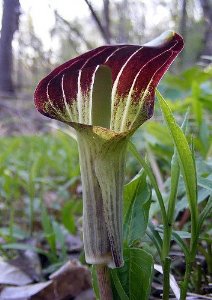
Bluebells or Virginia Bluebells, Mertensia virginica, is a perennial native to eastern North America from the southern Appalachians to Canada. It comes into bloom just as the first trees sprout leaves, and is usually finished blooming by late April or early May. The one to two foot arching stems have hanging clusters of lavender-blue flowers. Bloom size is one inch.
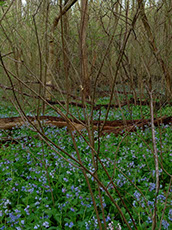
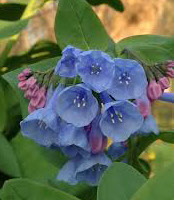

This is a quick guide to some of wildflowers you might see in bloom in our region in May. Do a web search on each plant for larger photos and detailed information. Spring blooming happens latter in the north and at higher altitude.
If you know of a flowering wild plant that is missing, contact webkeeper@amcdv.org. All photos are in the commons for non-commercial use, as is the information on this page.
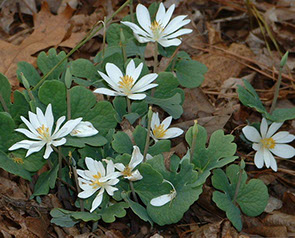
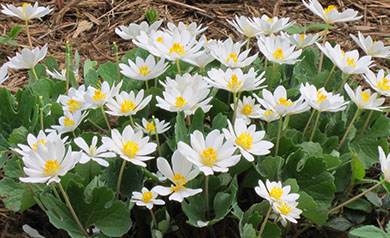
Bloodroot, Sanguinaria canadensis, is a perennial native to North America east of the Rockies. It has white flowers up to an inch and a half across, with eight to ten petals. The flowers bloom before the trees leaf out, and continue to bloom through April into early May.
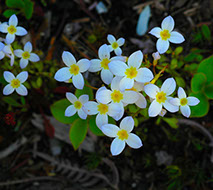
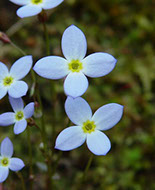
_hedyotis_caerulea.jpg?crc=98150787)
Bluets, Houstonia caerulea, native to eastern North America is a delicate perennial found in compact tufts about eight inches high. Tiny flowers, barely a half inch across, are pale blue with yellow centers. Occurs in open fields and woods from April to June.
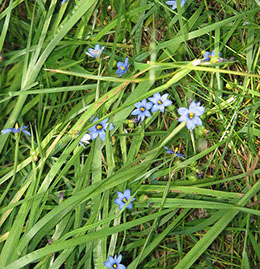

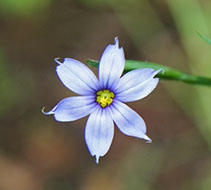
Blue-eyed Grass, Sisyrinchium angustifolium. A perennial native to eastern North America. Actually not a grass, but a member of the iris family. Grows in fields and at woodland verges, and blooms late March through May.
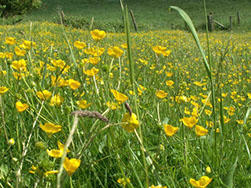

Buttercups, Ranunculus species. Many species of buttercups may found in our area, some native some not. Most bloom spring through fall, some lasting until frost. Sizes vary from about a half-inch to an inch across.
Buttercups include many species, and bloom from spring to fall.

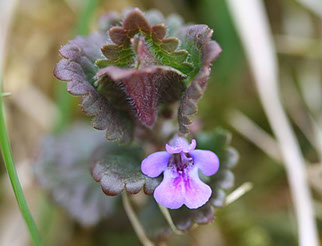
Ground Ivy, Glechoma hederacea, naturalized native of Europe and parts of Asia. Blooms April to July. Tiny flowers, usually a half inch or less across, and lobed leaves. Flowers are often in clusters of two or three. Prefers shaded, moist areas. The plant is toxic when eaten.
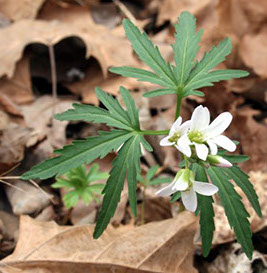

Cutleaf Toothwort, Dentaria laciniata, is a perennial native to North America east of the Rockies. Blooms April and May in our region.


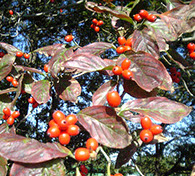
Native Dogwood, Cornus florida. Always white, and not to be confused with imported varieties. The fall fruits of the native tree are an important food for migrating song birds, unlike those of non-native species. The flowers are two to three inches across and bloom late April to early June in our region.
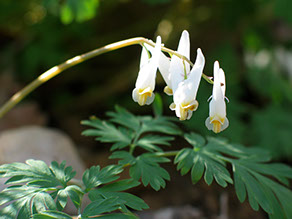

Dutchman's Britches, Dicentra cucullaria, is a perennial native to North America east of the Rockies except for the deep south. It has fern-like leaves and with multiple white flowers hanging from six to 10 inch long stems. The flowers are about an inch across, and have two lobes. The plant is insect polinated, and it's seeds distributed by ants. Blooms before the tree leaves come out.

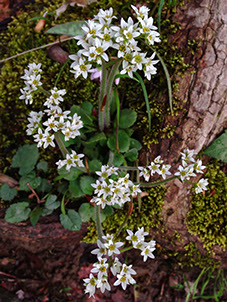

Early Saxifraga, Saxifraga virginiensis, Micranthes virginiensis, is an early blooming perennial native to eastern and central North America. It likes rocks, cliffs and logs. The plant grows to about 18 inches tall, ands has clusters of tiny white flowers that may be flecked with yellow.
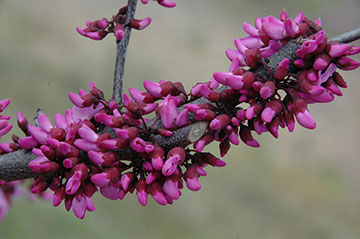

Eastern Redbud, Cercis canadensis, is a large deciduous shrub or small tree, native to eastern North America from Southern Ontario, Canada south to northern Florida. Its range extends west almost to the Rockies. In the wild it is generally an understory tree in mixed hardwood forests. It blooms before its leaves and the leaves of the forest trees appear, and may continue in bloom for some weeks. The flowers appear first as red-magenta beads all along the branches and the trunk.
1-crop-u20787.jpg?crc=390019689)
4-crop-u20789.jpg?crc=11700268)
.jpg?crc=4282645095)
Golden Ragwort, Senecio aureus. A perennial evergreen that blooms April through July. Native to eastern North America. The flowers are about a half inch across abd grow on strons stems about 1 to 3 foot tall.


Grape Hyacinth, Muscari botryoides, is a perennial native to Europe and found in woods and fields. It blooms in April and May in our region. It is small, and not particularly invasive.
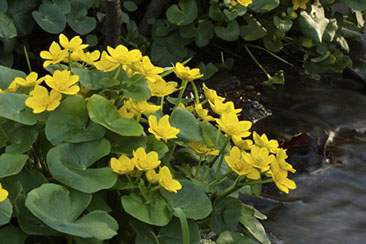

Marsh Marigold, Caltha palustris, a perennial native to most of North America except for the southern and Rocky Mountain states. Nlooms are an inch or more across, mostly with five petals, but occasilnally with four or up to nine. It has rich green glossy heart to kiudney shaped leaves, and grows in damp, swampy areas and along streams.
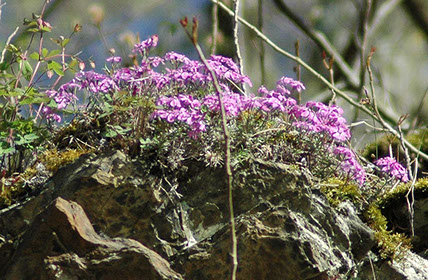
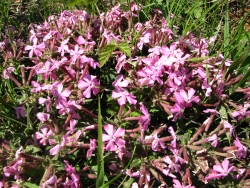
Wild Pink, Silene caroliniana, subspecies pensylvanica, is a perennial native to the northeast US from Virginia to central New England. Blooms April to June. Likes cliff faces and rocks, and is mosty often seen in clumps in nearly accessable locations.
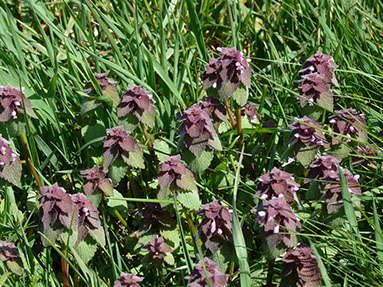
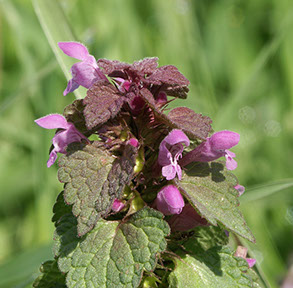
Purple Dead Nettle, Lamium purpureum, a annual Eurasian native now found across most of North America, It grows up to 10 inches high with leaves that have fine hairs, are green at the bottom and shade to purplish at the top. It is not a true nettle and does not sting, hence, dead nettle. This plant can be invasive and weedy. Blooms April through summer.

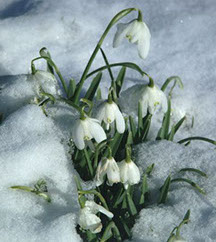
Snowdrop, Galanthus nivalis, and related species. These are introduced perennials native to Europe. They are likely to be the first flowers that bloom each year. They appear in in our area during the last days of winter or very early spring, often while snow is still on the ground.

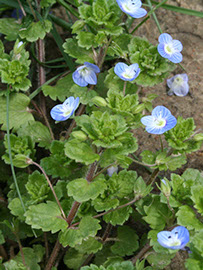
Speedwell, Persian Speedwell, Birdseye Speedwell, Veronica persica, is a seed propagated annual native to Eurasia found throughout North America. Blooms April to August with very tiny flowers less than a quarter inch across.


Spring Beauty, Claytonia virginica, a perennial native to eastern North America, blooms April into May in our region. The flower will fade, the seed pods ripen, and the above-ground part of the plant will disappear by early June. The plant overwinters as corms. It can be distinguished from the Carolina Spring Beauty (below) by its narrow grass-like leaves.
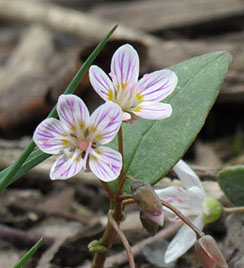

Carolina Spring Beauty, Claytonia caroliniana, a perennial native to eastern North America, blooms April into May in our region. The flower will fade, the seed pods ripen, and the above-ground part of the plant will disappear by early June. The plant overwinters as corms. It can be distinguished from the common Spring Beauty (above) by its broad leaves.
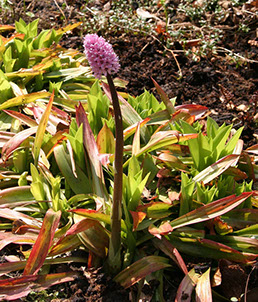
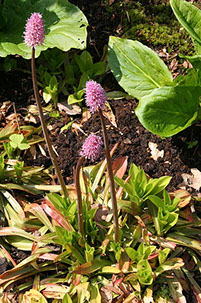
Swamp Pink, Helonias bullata, is native perennial of the lily family. It has smooth, dark green leaves that form an evergreen rosette. Rosettes produce a flowering stalk that can grow over 3 feet tall. It blooms late March through May. An officially threatened species, it is vulnerable to habitat loss due to development and wetland drainage. Half the remaining range of the plant is in southern New Jersey, with some in Delaware and bayshore Maryland and parts of Virginia.
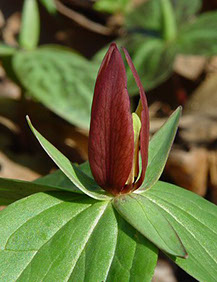
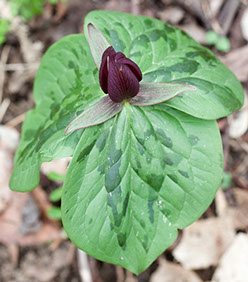
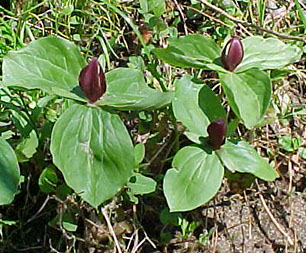
Toadshade, Red Trillium, Trillium sessile, a perennial native to the central part of the eastern United States and the Ozarks. It has a single red flower with a foul scent that grows directly from the middle of its three leaves.
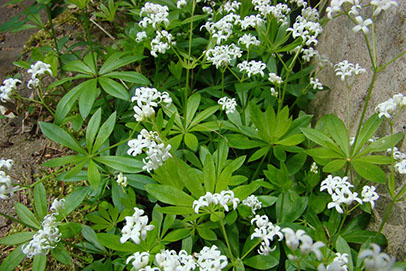
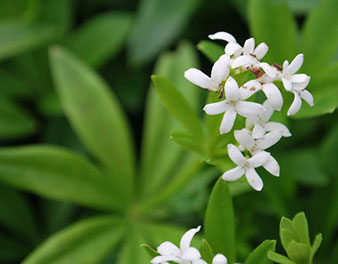
Sweetscented Bedstraw, Galium odoratum, is a flowering perennial plant, native to Eurasia. It is also sparingly naturalized in scattered locations in the United States and Canada. It is widely cultivated for its flowers and its sweet-smelling foliage. If you see it it is likely to be an escaped cultivar. Bloom April through (not yet determined) in our region.
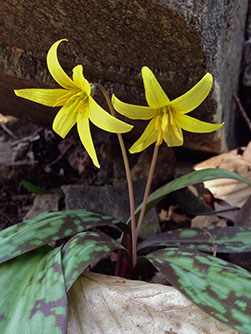

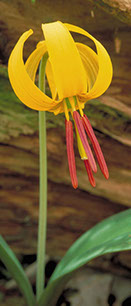
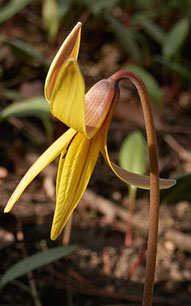
Trout Lily, Yellow trout Lily, Erythronium americanum, is a perennial native to eastern North America from the Atlantic to the Mississippi, and from Georgia north into Canada. It has one-inch yellow flowers, with three petals and and three petal-like sepals that curl upward. Each plant has a single flower stem with a pair of blade-shaped green leaves mottled with brown spots. Generally blooms before the tree leaves open.

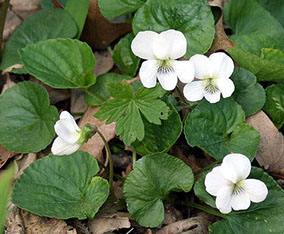
Sweet White Violet, Viola blanda, similar to Viola sororia, but with fragrant white flowers.

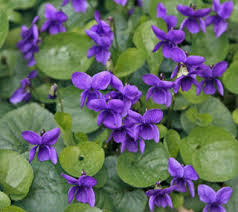
Violets, Viola sororia, synonym Viola papilionacea, is a native of eastern North America that can grow as an annual or as a perennial. Glossy, heart-shaped leaves may grow as tall as six to eight inches, topped with purple flowers with conspicuous white to yellow throats. Erect flower stem droop and produce whitish fruit with great quantities of seeds. Prefers damp woods and moist meadows. Bloom size a hal inch to an inch, they Bloom from April throughout summer. State flower of New Jersey.
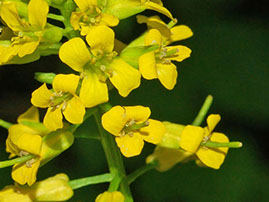
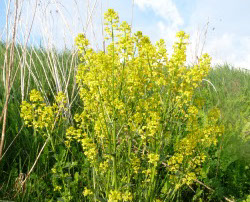
Wintercress or Yellow Rocket, Barbarea vulgaris, a Eurasian native now common across North America. Tufted plant with elongated clusters of small bright yellow flowers atop erect leafy stems. Frequently forms showy yellow patches in open fields. Bloom size about a third of an inch. Blooms April into summer. Originally introduced by early European settlers to provide a scurvy-curing early spring green, the plant is ediable. Very fragrant, and long-lasting as a cut flower.
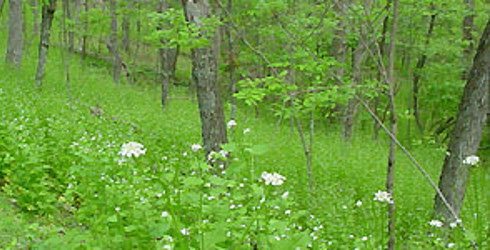
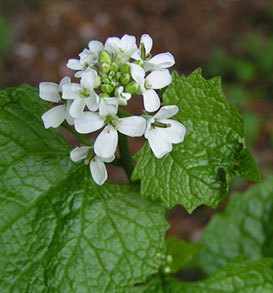
Problem Invasive: Garlic Mustard, Alliaria petiolata, a biennial native to Europe introduced either accidentally as a contaminant or deliberately as a food and medicinal herb in the late 19th century. It can self-pollinate, or be pollinated by insects. All parts of the plant exhibit a strong odor, particularly when crushed. Its weedy growth chokes out native species and thereby reduce food for native herbivors. More info.

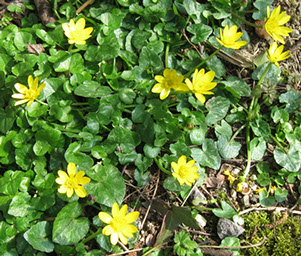
Problem Invasive: Lesser Celandine or Fig Buttercup, Ficaria verna formerly Ranunculus ficaria, Is a vigorous invasive that blooms in the spring, particularly along streams in the floodplain, often sprouting amd blooming before native species. It not only displaces native wildflowers, it provides no food for native pollinators just emerging in spring. Many of these starve to death, and their reduced numbers adversely affect both wild plants and food crops.
This plant, native to Europe, North Aferica and wastern Asia, is easily confused with the native Marsh Marigold. It frequently displaces that plant, Trout Lilies and Bluebells. Click here for more information. Despite the environmental harm this plant does, it is still legally sold as an ornamental in many states.
